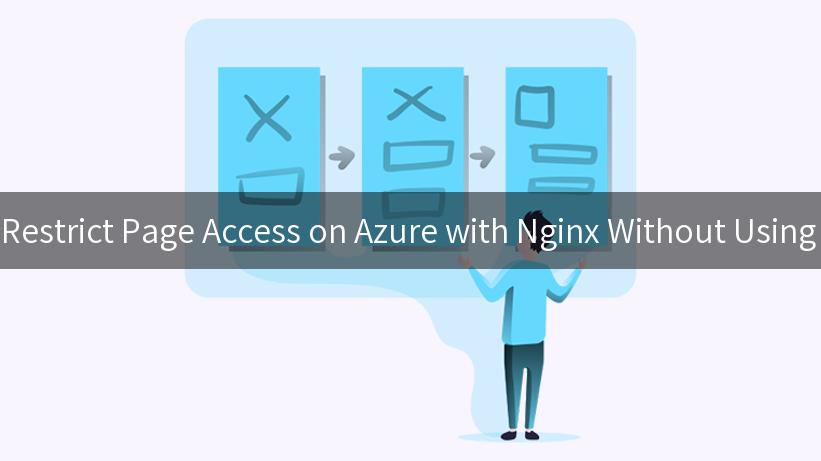
When deploying applications on Azure, ensuring that your web services are secure is essential. One way to manage this is by restricting access to certain pages or directories without relying on external plugins, such as through the use of NGINX. This article will provide a detailed guide on how to restrict page access on Azure using NGINX. Additionally, we will explore some advanced topics including leveraging AI for security enhancements, understanding API runtime statistics, and integrating with tools like Træfik which facilitates the management of networking configurations.
Setting Up NGINX on Azure
Before we get into page access restriction, let’s briefly discuss setting up NGINX on Azure.
-
Create an Azure Virtual Machine: Choose the Linux distribution that you prefer (Ubuntu is a common choice).
-
Install NGINX: Once your VM is set up, connect via SSH and install NGINX with the following commands:
bash
sudo apt update
sudo apt install nginx
-
Start and Enable NGINX:
bash
sudo systemctl start nginx
sudo systemctl enable nginx
-
Configure Firewall: Ensure that necessary ports (like 80 and 443) are open:
bash
sudo ufw allow 'Nginx Full'
Basic NGINX Configuration
Before restricting access, it’s essential to understand the basic structure of an NGINX configuration file (nginx.conf). This file typically resides in /etc/nginx. A configuration block might look like this:
server {
listen 80;
server_name your_domain.com;
location / {
root /var/www/html;
index index.html index.htm;
}
}
Restricting Access Without Using Plugins
1. Restricting via IP Address
One straightforward way to restrict access is by IP address. You can allow or deny access based on a client’s IP.
Here’s how you can configure it:
server {
listen 80;
server_name your_domain.com;
location /restricted {
allow 203.0.113.0; # Replace this with the IP you want to allow
deny all;
# The rest of your configurations
}
}
2. Password Protection with Basic Auth
Another method to restrict access is by using Basic Authentication. First, install Apache2-utils to create a password file.
sudo apt install apache2-utils
htpasswd -c /etc/nginx/.htpasswd username
Add this to your NGINX configuration:
location /restricted {
auth_basic "Restricted Content";
auth_basic_user_file /etc/nginx/.htpasswd;
}
3. Using Custom Logic with Echo Module
For advanced scenarios, using the NGINX echo module allows you to implement custom access logic. But, it may need installation and integration with your NGINX setup. An example to check for a specific query parameter could look like:
location /restricted {
set $access "0";
if ($arg_key = "MY_SECRET_KEY") {
set $access "1";
}
if ($access = "0") {
return 403;
}
}
4. Using AI for Security Enhancements
As we talk about enhancing security, integrating AI solutions could significantly bolster your page access management strategies. AI can analyze traffic patterns, detect unusual access attempts, and allow for automated responses to threats. Tools like Azure AI Security can provide insights into trends and potential vulnerabilities.
5. Integrating with Træfik for Advanced Routing
Træfik is a modern HTTP reverse proxy and load balancer that makes deploying microservices easy. By integrating Træfik with NGINX, you can achieve more sophisticated traffic management and user access control.
To do this, install Træfik on your Azure environment and configure it to handle requests before they reach NGINX. Here’s a simplified example configuration:
http:
middlewares:
auth:
basicAuth:
users:
- "username:hashed_password"
routers:
myrouter:
rule: "Host(`your_domain.com`)"
entrypoints:
- web
middlewares:
- auth
service: myservice
Monitoring API Runtime Statistics
After setting up your NGINX configurations to restrict page access, you will want to monitor your API usage and performance. Azure provides built-in tools to view API runtime statistics, allowing you to analyze request rates, error rates, and more.
Creating an API Statistics Dashboard
You can create a dashboard using Azure Monitor to keep track of the key metrics surrounding your API usage:
| Metric |
Description |
| Requests |
Total number of requests made |
| Error Rate |
Percentage of requests that resulted in an error |
| Latency |
Average response time |
| Bandwidth |
Total amount of data transferred |
Conclusion
In this guide, we explored how to restrict page access on Azure using NGINX without relying on plugins. We highlighted three primary methods: IP address restriction, Basic Authentication, and custom access logic through the NGINX echo module. Additionally, we discussed how AI can enhance security and how integrating with Træfik can provide advanced routing solutions.
In the ever-evolving landscape of web security, understanding and implementing these strategies will not only help you secure your applications but also provide insights into usage patterns through API runtime statistics. As you continue to deploy applications in Azure, remember that security is a continuous process that requires constant attention and adaptation.
APIPark is a high-performance AI gateway that allows you to securely access the most comprehensive LLM APIs globally on the APIPark platform, including OpenAI, Anthropic, Mistral, Llama2, Google Gemini, and more.Try APIPark now! 👇👇👇
This comprehensive approach aligns with modern security protocols, ensuring that your applications are robust against unauthorized access while maintaining ease of use for legitimate users. Happy configuring!